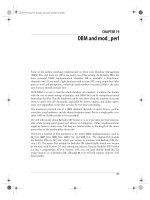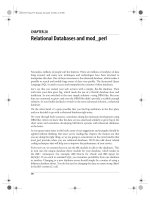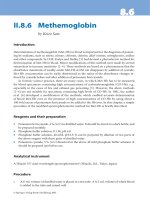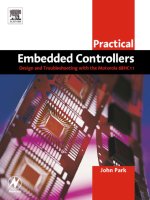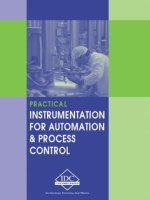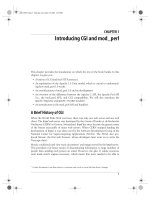Practical mod_perl-CHAPTER 19:DBM and mod_perl
Bạn đang xem bản rút gọn của tài liệu. Xem và tải ngay bản đầy đủ của tài liệu tại đây (482.57 KB, 15 trang )
This is the Title of the Book, eMatter Edition
Copyright © 2004 O’Reilly & Associates, Inc. All rights reserved.
555
Chapter 19
CHAPTER 19
DBM and mod_perl
Some of the earliest databases implemented on Unix were Database Management
(DBM) files, and many are still in use today.As of this writing, the Berkeley DB is the
most powerful DBM implementation.Berkeley DB is available at http://www.
sleepycat.com/.If you need a light database with an easy API, using simple key-value
pairs to store and manipulate a relatively small number of records, DBM is the solu-
tion that you should consider first.
With DBM, it is rare to read the whole database into memory.Combine this feature
with the use of smart storage techniques, and DBM files can be manipulated much
faster than flat files.Flat-file databases can be very slow when the number of records
starts to grow into the thousands, especially for insert, update, and delete opera-
tions. Sort algorithms on flat files can also be very time-consuming.
The maximum practical size of a DBM database depends on many factors, such as
your data, your hardware, and the desired response times.But as a rough guide, con-
sider 5,000 to 10,000 records to be reasonable.
We will talk mostly about Berkeley DB Version 1.x, as it provides the best function-
ality while having good speed and almost no limitations.Other implementations
might be faster in some cases, but they are limited either in the length of the maxi-
mum value or the total number of records.
There are a number of Perl interfaces to the major DBM implementations, such as
DB_File
,
NDBM_File
,
ODBM_File
,
GDBM_File
, and
SDBM_File
.The original Perl module
for Berkeley DB was
DB_File
, which was written to interface with Berkeley DB Ver-
sion 1.85. The newer Perl module for Berkeley DB is
BerkeleyDB
, which was written
to interface with Version 2.0 and subsequent releases. Because Berkeley DB Version
2.x has a compatibility API for Version 1.85, you can (and should) build
DB_File
using Version 2.x of Berkeley DB, although
DB_File
will still support only the 1.85
functionality.
,ch19.25158 Page 555 Thursday, November 18, 2004 12:44 PM
This is the Title of the Book, eMatter Edition
Copyright © 2004 O’Reilly & Associates, Inc. All rights reserved.
556
|
Chapter 19: DBM and mod_perl
Several different indexing algorithms (known also as access methods) can be used
with DBM implementations:
• The
HASH
access method gives an O(1) complexity (see sidebar) of search and
update, fast insert, and delete, but a slow sort (which you have to implement
yourself).
HASH
is used by almost all DBM implementations.
• The
BTREE
access method allows arbitrary key/value pairs to be stored in a
sorted, balanced binary tree.This allows you to get a sorted sequence of data
pairs in O(1) (see sidebar), at the expense of much slower insert, update, and
delete operations than is the case with
HASH
.
BTREE
is available mostly in Berkeley
DB.
• The
RECNO
access method is more complicated, and enables both fixed-length
and variable-length flat text files to be manipulated using the same key/value
pair interface as in
HASH
and
BTREE
.In this case the key will consist of a record
(line) number.
RECNO
is available mostly in Berkeley DB.
• The
QUEUE
access method stores fixed-length records with logical record num-
bers as keys.It is designed for fast inserts at the tail and has a special cursor-
consume operation that deletes and returns a record from the head of the queue.
The
QUEUE
access method uses record-level locking.
QUEUE
is available only in Ber-
keley DB Version 3.0 and higher.
Most often you will want to use the
HASH
method, but there are many considerations
and your choice may be dictated by your application.
In recent years, DBM databases have been extended to allow you to store more com-
plex values, including data structures.The
MLDBM
module can store and restore the
whole symbol table of your script, including arrays and hashes.
It is important to note that you cannot simply switch a DBM file from one storage
algorithm to another.The only way to change the algorithm is to copy all the records
Big-O Notation
In math, complexity is expressed using big-O notation. For a problem of size N:
• A constant-time method is “order 1”: O(1)
• A linear-time method is “order N”: O(N)
• A quadratic-time method is “order N squared”: O(N
2
)
For example, a lookup action in a properly implemented hash of size N with random
data has a complexity of O(1), because the item is located almost immediately after its
hash value is calculated.However, the same action in the list of N items has a complex-
ity of O(N), since on average you have to go through almost all the items in the list
before you find what you need.
,ch19.25158 Page 556 Thursday, November 18, 2004 12:44 PM
This is the Title of the Book, eMatter Edition
Copyright © 2004 O’Reilly & Associates, Inc. All rights reserved.
mod_perl and DBM
|
557
one by one into a new DBM file, initialized according to a desired access method.
You can use a script like the one shown in Example 19-1.
Note that some DBM implementations come with other conversion utilities as well.
mod_perl and DBM
Where does mod_perl fit into the picture? If you need read-only access to a DBM file
in your mod_perl code, the operation is much faster if you keep the DBM file open
Example 19-1. btree2hash.pl
#!/usr/bin/perl -w
#
# This script takes as its parameters a list of Berkeley DB
# file(s) which are stored with the DB_BTREE algorithm. It
# will back them up using the .bak extension and create
# instead DBMs with the same records but stored using the
# DB_HASH algorithm.
#
# Usage: btree2hash.pl filename(s)
use strict;
use DB_File;
use Fcntl;
# @ARGV checks
die "Usage: btree2hash.pl filename(s))\n" unless @ARGV;
for my $filename (@ARGV) {
die "Can't find $filename: $!"
unless -e $filename and -r _;
# First back up the file
rename "$filename", "$filename.btree"
or die "can't rename $filename with $filename.btree: $!";
# tie both DBs (db_hash is a fresh one!)
tie my %btree , 'DB_File',"$filename.btree", O_RDWR|O_CREAT,
0660, $DB_BTREE or die "Can't tie $filename.btree: $!";
tie my %hash , 'DB_File',"$filename" , O_RDWR|O_CREAT,
0660, $DB_HASH or die "Can't tie $filename: $!";
# copy DB
%hash = %btree;
# untie
untie %btree;
untie %hash;
}
,ch19.25158 Page 557 Thursday, November 18, 2004 12:44 PM
This is the Title of the Book, eMatter Edition
Copyright © 2004 O’Reilly & Associates, Inc. All rights reserved.
558
|
Chapter 19: DBM and mod_perl
(tied) all the time and therefore ready to be used.We will see an example of this in a
moment.This will work with dynamic (read/write) database accesses as well, but
you need to use locking and data flushing to avoid data corruption.
It’s possible that a process will die, for various reasons.There are a few conse-
quences of this event.
If the program has been using external file locking and the lock is based on the exist-
ence of the lock file, the code might be aborted before it has a chance to remove the
file.Therefore, the next process that tries to get a lock will wait indefinitely, since the
lock file is dead and no one can remove it without manual intervention.Until this
lock file is removed, services relying on this lock will stay deactivated.The requests
will queue up, and at some point the whole service will become useless as all the pro-
cesses wait for the lock file.Therefore, this locking technique is not recommended.
Instead, an advisory
flock( )
method should be used.With this method, when a pro-
cess dies, the lock file will be unlocked by the operating system, no matter what.
Another issue lies in the fact that if the DBM files are modified, they have to be prop-
erly closed to ensure the integrity of the data in the database.This requires a flush-
ing of the DBM buffers, or just untying of the database.In case the code flow is
aborted before the database is flushed to disk, use Perl’s
END
block to handle the
unexpected situations, like so:
END { my_dbm_flush( ) }
Remember that under mod_perl, this will work on each request only for
END
blocks
declared in scripts running under
Apache::Registry
and similar handlers.Other Perl
handlers need to use the
$r->register_cleanup( )
method:
$r->register_cleanup(\&my_dbm_flush);
as explained in Chapter 6.
As a rule, your application should be tested very thoroughly before you put it into
production to handle important data.
Resource Locking
Database locking is required if more than one process will try to modify the data.In
an environment in which there are both reading and writing processes, the reading
processes should use locking as well, since it’s possible for another process to mod-
ify the resource at the same moment, in which case the reading process gets cor-
rupted data.
We distinguish between shared-access and exclusive-access locks.Before doing an
operation on the DBM file, an exclusive lock request is issued if a read/write access is
required. Otherwise, a shared lock is issued.
,ch19.25158 Page 558 Thursday, November 18, 2004 12:44 PM
This is the Title of the Book, eMatter Edition
Copyright © 2004 O’Reilly & Associates, Inc. All rights reserved.
Resource Locking
|
559
Deadlocks
First let’s make sure that you know how processes work with the CPU.Each process
gets a tiny CPU time slice before another process takes over.Usually operating sys-
tems use a “round robin” technique to decide which processes should get CPU slices
and when.This decision is based on a simple queue, with each process that needs
CPU entering the queue at the end of it.Eventually the added process moves to the
head of the queue and receives a tiny allotment of CPU time, depending on the pro-
cessor speed and implementation (think microseconds).After this time slice, if it is
still not finished, the process moves to the end of the queue again.Figure 19-1
depicts this process.(Of course, this diagram is a simplified one; in reality various
processes have different priorities, so one process may get more CPU time slices than
others over the same period of time.)
Now let’s talk about the situation called deadlock.If two processes simultaneously
try to acquire exclusive locks on two separate resources (databases), a deadlock is
possible. Consider this example:
sub lock_foo {
exclusive_lock('DB1');
exclusive_lock('DB2');
}
sub lock_bar {
exclusive_lock('DB2');
exclusive_lock('DB1');
}
Suppose process A calls
lock_foo( )
and process B calls
lock_bar( )
at the same time.
Process A locks resource
DB1
and process B locks resource
DB2
.Now suppose process
A needs to acquire a lock on
DB2
, and process B needs a lock on
DB1
.Neither of them
can proceed, since they each hold the resource needed by the other.This situation is
called a deadlock.
Using the same CPU-sharing diagram shown in Figure 19-1, let’s imagine that pro-
cess A gets an exclusive lock on
DB1
at time slice 1 and process B gets an exclusive
lock on
DB2
at time slice 2.Then at time slice 4, process A gets the CPU back, but it
cannot do anything because it’s waiting for the lock on
DB2
to be released.The same
thing happens to process B at time slice 5.From now on, the two processes will get
the CPU, try to get the lock, fail, and wait for the next chance indefinitely.
Figure 19-1. CPU time allocation
CPU time
Process A
Process B
Process C
1234567
,ch19.25158 Page 559 Thursday, November 18, 2004 12:44 PM
This is the Title of the Book, eMatter Edition
Copyright © 2004 O’Reilly & Associates, Inc. All rights reserved.
560
|
Chapter 19: DBM and mod_perl
Deadlock wouldn’t be a problem if
lock_foo( )
and
lock_bar( )
were atomic, which
would mean that no other process would get access to the CPU before the whole
subroutine was completed.But this never happens, because all the running pro-
cesses get access to the CPU only for a few milliseconds or even microseconds at a
time (called a time slice).It usually takes more than one CPU time slice to accom-
plish even a very simple operation.
For the same reason, this code shouldn’t be relied on:
sub get_lock {
sleep 1, until -e $lock_file;
open LF, $lock_file or die $!;
return 1;
}
The problem with this code is that the test and the action pair aren’t atomic.Even if
the
-e
test determines that the file doesn’t exist, nothing prevents another process
from creating the file in between the
-e
test and the next operation that tries to cre-
ate it. Later we will see how this problem can be resolved.
Exclusive Locking Starvation
If a shared lock request is issued, it is granted immediately if the file is not locked or
has another shared lock on it.If the file has an exclusive lock on it, the shared lock
request is granted as soon as that lock is removed.The lock status becomes
SHARED
on success.
If an exclusive lock is requested, it is granted as soon as the file becomes unlocked.
The lock status becomes
EXCLUSIVE
on success.
If the DB has a shared lock on it, a process that makes an exclusive lock request will
poll until there are no reading or writing processes left.Lots of processes can success-
fully read the file, since they do not block each other.This means that a process that
wants to write to the file may never get a chance to squeeze in, since it needs to
obtain an exclusive lock.
Figure 19-2 represents a possible scenario in which everybody can read but no one
can write.(“pX” represents different processes running at different times, all acquir-
ing shared locks on the DBM file.)
Figure 19-2. Overlapping shared locks prevent an exclusive lock
p1
p2
p3
p4
p1
p2
p3
,ch19.25158 Page 560 Thursday, November 18, 2004 12:44 PM
